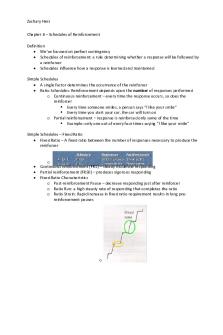Chapter 17 Ratio Schedules PDF

| Title | Chapter 17 Ratio Schedules |
|---|---|
| Author | Sunho Kim |
| Course | Basics of Behavior Analysis |
| Institution | National University (US) |
| Pages | 3 |
| File Size | 150.1 KB |
| File Type | |
| Total Downloads | 107 |
| Total Views | 160 |
Summary
Principles of Behavior by Malott (7th) Ch:17...
Description
Chapter 17: Ratio Schedules Continuous Reinforcement (CRF) - a reinforcer follows each response -
Usually best for shaping or maintaining difficult behavior (shaping vocal responses)
Intermittent Reinforcement Schedule - reinforcement schedule in which a reinforcer follows the response only once in awhile Schedule of Reinforcement - the way reinforcement occurs because of the number of responses, time since reinforcement, time between responses, and stimulus conditions Fixed-Ratio (FR) Schedule of Reinforcement - a reinforcer is contingent on the last of a fixed number of responses -
With fairly large ratios (100 responses/reinforcer), there is usually a consistent pattern of responding - high rate of responding until reinforcer is delivered followed by a pause before responding starts again
Fixed-Ratio Responding - after a response is reinforced, no responding occurs for a period of time, then responding occurs at a high, steady rate until the next reinforcer is delivered Post-Reinforcement Pause - the pause after the consumption of the reinforcer and before the next ratio of responses begins -
Characteristic of fixed-ratio maintained behavior; length of pause is proportional to size of ratio
-
If you want to establish a high ratio requirement, you need to do it gradually; otherwise responding will extinguish
General Rule for Establishing Intermittently Reinforced Behavior - first use continuous reinforcement and gradually increase the intermittency of reinforcement as responding stabilizes at a high rate -
The higher the ratio, the more important it is to introduce it gradually through lower initial ratios
-
Extinction due to making the ratio too high too quickly is called straining the ratio
-
By gradually increasing the requirement, we can minimize # of reinforcers needed to maintain behavior
Cumulative Graph - often used to study schedules of reinforcement -
Vertical axis is cumulative frequency of responses (vs. non-cumulative graph where the vertical axis is labeled responses)
-
The post reinforcement pause is where the slope of the line is zero
Variable Ratio(VR) Schedule of Reinforcement - a reinforcer is contingent on the last of a variable number of responses Variable Ratio Responding - variable ratio schedules produce a high rate of responding, with almost no post-reinforcement pausing Example: -
VR 50; 50 designates the average number of responses required for the reinforcer
Intermittent Reinforcement - generic term that includes both fixed and variable ratio schedules 4 Reasons Why Slot Machines Are NOT VR Schedules 1. It’s loaded with learned reinforcers in addition to the silver dollars (fruits that appear in the window, one after the other/you get 2 cherries in a row - a big reinforcer) 2. The variable amount of the reinforcer you get at the end of the so-called VR a. Sometimes you get 1 silver dollar, sometimes 10, 18, etc. 3. Size of the ratio is much smaller than is typical in the Skinner box of the professional research lab (ie. VR 100; people would not play if machines had ratios of 100) 4. The emotional reaction itself is reinforcing Most of our contingencies of everyday life involve more or less continuous reinforcement & continuous punishment Free-Operant Procedure - animal is free to respond at various frequencies (1 lever press/min to 100 lever presses/min) -
If the animal can make more than 1 correct response before the reinforcer, it is probably a free-operant procedure
-
There is no S-delta after each response, so there is no inter-trial interval between each response and the next SD
-
There may or may not be an SD; then there can be several responses, with the responses being reinforced either continuously/intermittently
Discrete Trial Procedure - there is an SD, a single response, and an outcome, followed by a S-delta (intertrial interval); then the next trial starts -
After single response occurs, the SD ends and the subject immediately receives a reinforcer or goes into S-delta...
Similar Free PDFs

Chapter 17 Ratio Schedules
- 3 Pages

17 - Chapter 17
- 23 Pages

Communication Schedules
- 2 Pages

Ratio
- 4 Pages

Chapter 17
- 9 Pages

Chapter 17
- 15 Pages

Chapter 17
- 41 Pages

Chapter 17
- 5 Pages

Chapter 17
- 9 Pages

Chapter 17
- 6 Pages

Chapter 17 - Lecture notes 17
- 15 Pages

Chapter 17
- 3 Pages

Chapter 17
- 34 Pages

Chapter 17 - Lecture notes 17
- 7 Pages
Popular Institutions
- Tinajero National High School - Annex
- Politeknik Caltex Riau
- Yokohama City University
- SGT University
- University of Al-Qadisiyah
- Divine Word College of Vigan
- Techniek College Rotterdam
- Universidade de Santiago
- Universiti Teknologi MARA Cawangan Johor Kampus Pasir Gudang
- Poltekkes Kemenkes Yogyakarta
- Baguio City National High School
- Colegio san marcos
- preparatoria uno
- Centro de Bachillerato Tecnológico Industrial y de Servicios No. 107
- Dalian Maritime University
- Quang Trung Secondary School
- Colegio Tecnológico en Informática
- Corporación Regional de Educación Superior
- Grupo CEDVA
- Dar Al Uloom University
- Centro de Estudios Preuniversitarios de la Universidad Nacional de Ingeniería
- 上智大学
- Aakash International School, Nuna Majara
- San Felipe Neri Catholic School
- Kang Chiao International School - New Taipei City
- Misamis Occidental National High School
- Institución Educativa Escuela Normal Juan Ladrilleros
- Kolehiyo ng Pantukan
- Batanes State College
- Instituto Continental
- Sekolah Menengah Kejuruan Kesehatan Kaltara (Tarakan)
- Colegio de La Inmaculada Concepcion - Cebu

